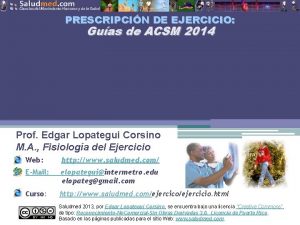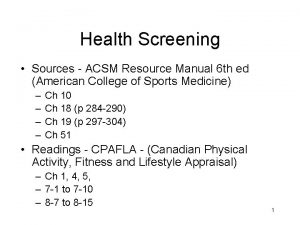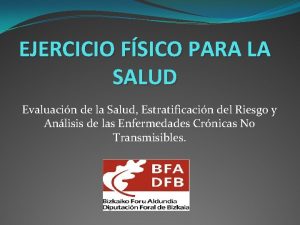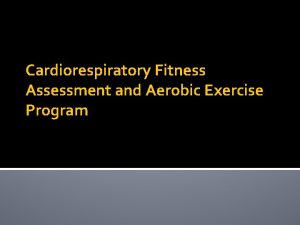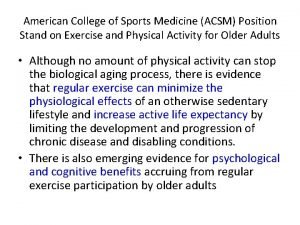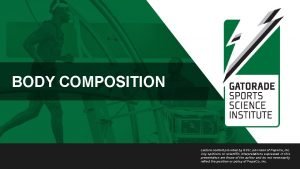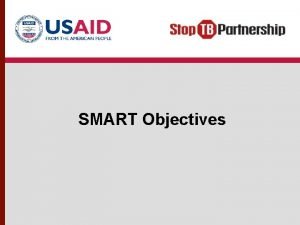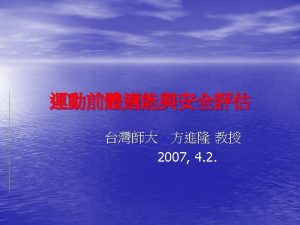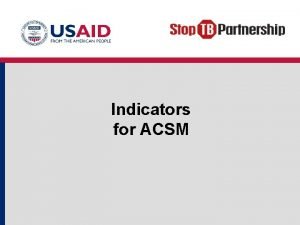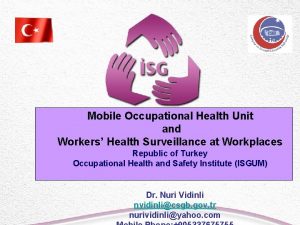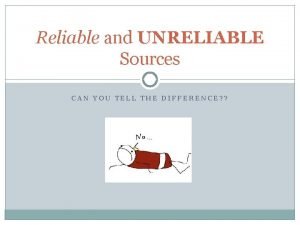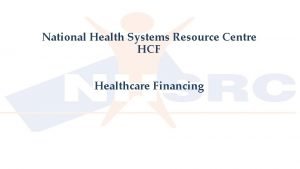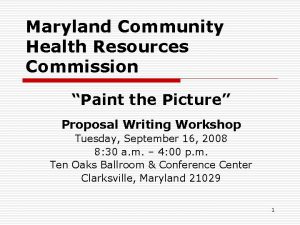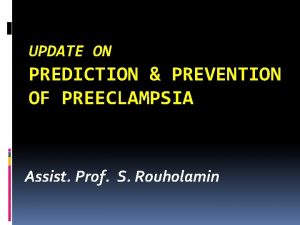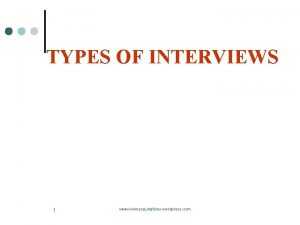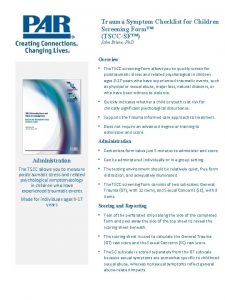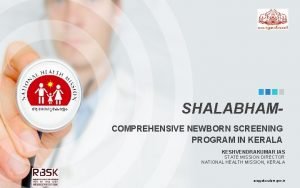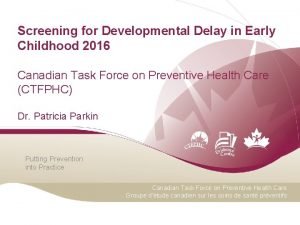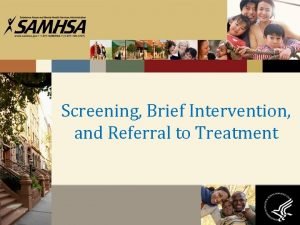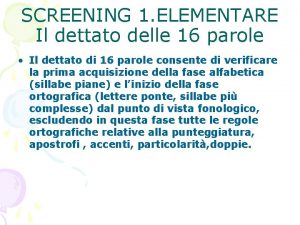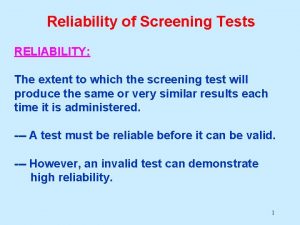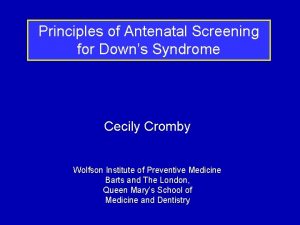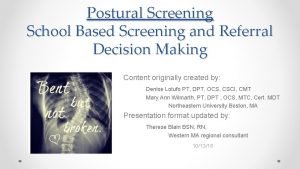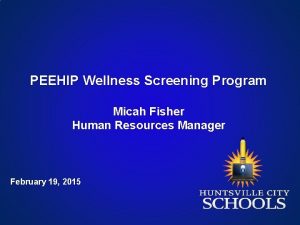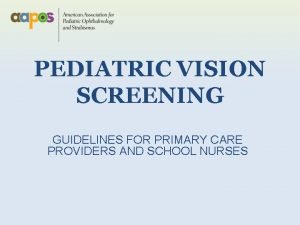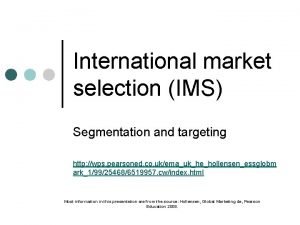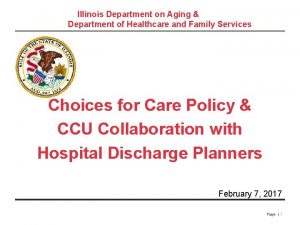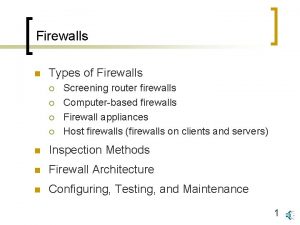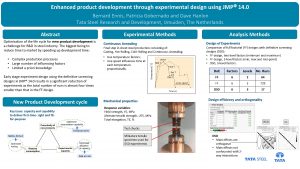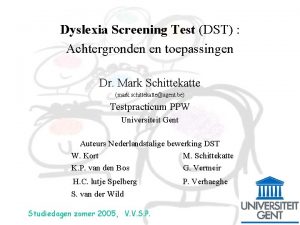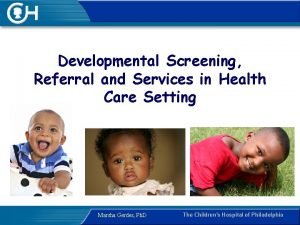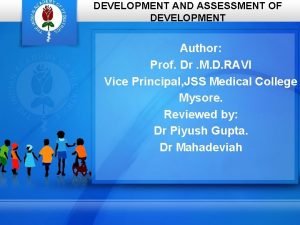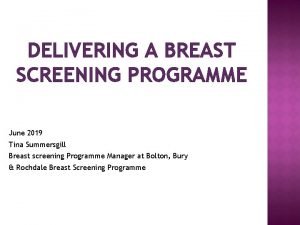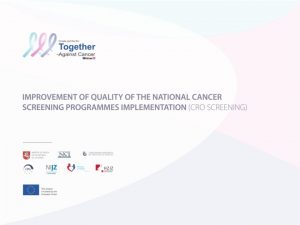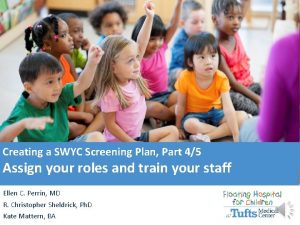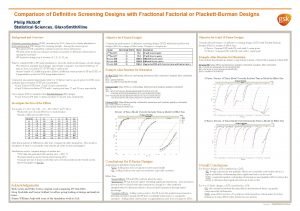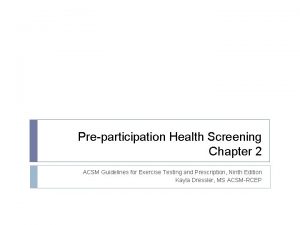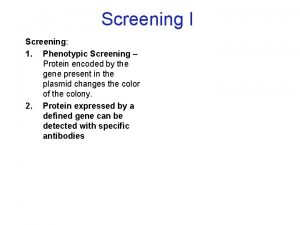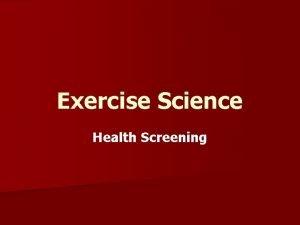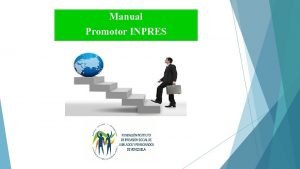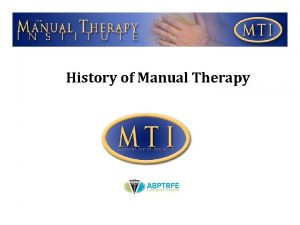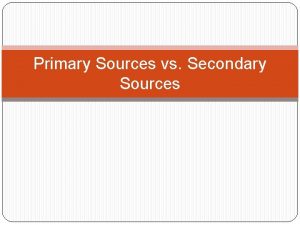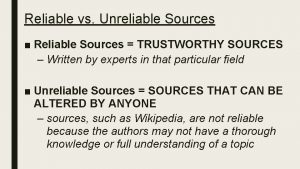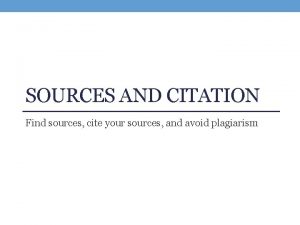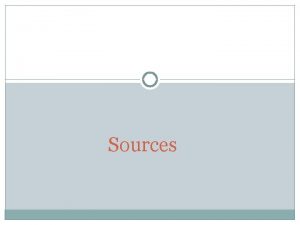Health Screening Sources ACSM Resource Manual 6 th

















































- Slides: 49

Health Screening • Sources - ACSM Resource Manual 6 th ed (American College of Sports Medicine) – – Ch 10 Ch 18 (p 284 -290) Ch 19 (p 297 -304) Ch 51 • Readings - CPAFLA - (Canadian Physical Activity, Fitness and Lifestyle Appraisal) – Ch 1, 4, 5, – 7 -1 to 7 -10 – 8 -7 to 8 -15 1

Outline - Health Screening • Role Of Appraiser • Goals of Health Screening – HS Forms - details and limitations – Overview of Risk Factors we are screening for • Physical Screening Tests – Resting Blood Pressure and Heart Rate • Safety and Legal Concerns 2

3

Wellness Continuum Figure 1. 1 4

Role of the Appraiser The appraisal can trigger changes and influence the personal health practices of clients. However, counseling sessions and dialogue with the client can be just as important.

Role Of Appraiser • Appraise clients physical activity and lifestyle habits • Design program (along with client) to improve fitness, coping skills and sense of mastery in life • Refer clients to other health professionals • Rely on these professionals to provide information and support for the goals you have assisted the client in developing • Client Based Approach, Appraiser is part of a team of Professionals 6

Characteristics of the Appraisal • • Historical performance related single procedure for all clients emphasis on fitness focus on prescribed exercise (FITT) tests and measures assumed readiness for change appraisal-reappraisal • • Current health related Procedural options emphasis on physical activity consider broader lifestyle issues information and advice recognizes/helps “nonmovers” various contact scenarios

Options and Scenarios CPAFLA • Full appraisal - CPAFLA 7 Step Model • Partial appraisal, with regrets – Client fails part of pre-screening • Partial appraisal by choice • Help, tips and advice only • Follow up options – Single session – Appraisal and reappraisal – Appraisal and ongoing contact

CPAFLA 7 Step Model • Step 1: Rapport and Structure • Step 2: Gathering Information • Step 3: Conduct the Health-Related Fitness Appraisal • Step 4: Interpret Physical Activity and Lifestyle Questionnaires and Health-Related Fitness Appraisal Results • Step 5: Generate and Evaluate Alternatives for Change • Step 6: Develop an Action Plan • Step 7: Follow Up 9

10

Dose Response to Activity • Figures 1 -3 and 1 -4 in CPAFLA • Improvements will vary depending on change in volume of activity • and clients place on benefit curve in relation to each component evaluated • Figure 4 -1 CPAFLA • Dose Response and Health Benefit Zones • Emphasize knowledge of client and approach to counseling 11

12

13

14

CPAFLA Health Benefit Zones • Excellent - Associated with optimal health benefits • Very Good - Associated with considerable benefits • Good - Associated with many health benefits • Fair - Associated with some benefits, but also some health risks • Needs improvement - Associated with considerable health risks

Pre-participation Screening • Most prospective participants are apparently healthy • Primary safety goal of health screening is to identify those who should receive further medical evaluation prior to exercise testing or training – identify medical conditions – identify possible contraindicated activities – Is referral to a medically supervised exercise program needed? • Information gathered can assist in designing an individualized exercise program • Following screening protocol will fulfill legal and insurance requirements 16

Instructions to Client • Recommendations prior to screening – – – Do not eat for at least 2 hrs prior Refrain from caffeine for 2 hrs prior Refrain from alcohol for 6 hrs prior Should not smoke during 2 hrs prior Exercise should be avoided for 6 hrs prior If client is taking medication for CV or metabolic function active component of assessment should not be done (ie aerobic tests - m. CAFT, coopers) – Pregnant women require doctors consent 17

Pre-participation Screening • CPAFLA guidelines • Forms – PAR-Q • PARMED X if client fails PAR-Q – LIFESTYLE checklist – Physical Screening - HR, BP and observations – Activity history – * KIN 343 adds health history to above requirements • Physical Screening – HR – BP – Observations 18

19

20

Health Screening Forms • PAR-Q - developed in BC, used worldwide – Brief, Self administered • Appraiser can not assist or interpret for client – Contact physician if YES answered to one or more questions - use PARMED X form • Sensitivity - nearly 100% – % with medical contraindications who answer Yes • Specificity - ~ 80% – % of persons without medical conditions who answer NO 21

Limitations of PAR-Q • Limited sensitivity and specificity for predicting exercise ECG abnormalities • Inability to screen out persons with 2 or more major CAD risk factors • Automatic referral if over 69 • Inability to Identify medications that may affect exercise safety • Inability to Identify pregnancy • Absence of questions that identify adverse health behaviors 22

23

24

343 adds - Health History • Important to assess risk for CAD and other chronic diseases • Several risk factors depend on behavior • Participants health behaviors should be assessed • Personal History is used to – – Clarify risk of CAD events during exercise Prioritize interventions Encourage change in lifestyle and reduce disease Develop or modify exercise program 25

Pre-participation Screening • ACSM guidelines – Minimum required is self administered questionnaire such as PAR-Q – Does not require medical exam for asymptomatic, apparently healthy men under 45 and women under 55 with fewer than two CAD risk factors (see slides 24 and 25 for details) • For vigorous exercise above 60% VO 2 max – Also, medical exam unnecessary for anyone asymptomatic and apparently healthy to undergo moderate exercise at 40 -60% VO 2 max 26

27

28

29

Other Risks to Consider • Chronic obstructive pulmonary disease – bronchitis, asthma, emphysema • Metabolic disorders – diabetes, hyper/hypothyroidism • Musculoskeletal – herniated disk, arthritis • Other conditions – pregnancy, hernia, illness, infection 30

Other Considerations • The properties of drugs must be understood and discussed with a physician – May alter HR / BP; ECG response, exercise capacity • Link between dietary habits and development of disease • Past and current exercise behaviours / habits • What do they enjoy? • Type A behaviour? • Eating Disorders? • Age and Exercise Intentions? – how old is this person and how vigorously does he or she want to exercise? 31

Physical Screening Tests Client may be unaware of a risk factor! • blood pressure • heart rate • observation 32

Blood Pressure indications that fail screening • CPAFLA - systolic > 145 - diastolic > 95 - On BP medication • ACSM - systolic > 140 - diastolic > 90 33

34

35

Classification of Blood Pressure for Adults Classification Systolic (mm. Hg) Diastolic (mm. Hg) Normal < 120 < 80 Pre Hypertension 120 - 130 80 - 89 Stage 1 140 - 159 90 - 99 Stage 2 > 160 > 100 Risk of CVD, beginning at 115 / 75 mm. Hg, doubles with each increment of 20 / 10 mm. Hg 36

Heart Rate indications that fail screening • CPAFLA and ACSM HR > 100 bts/min at rest • ACSM cautions about HR < 60 in an untrained individual at rest 37

Observation indicating failure of screening • • shortness of breath coughing persistently pregnant lower extremity swelling posture limp flexibility and strength? 38

39

Safety and Legal Concerns • The main concern of a fitness program is that it be conducted safely for everyone permitted to participate in the program. • The first step is obviously to screen and exclude those individuals who should not be exercising prior to checking with a physician. • It is then imperative to ensure that the program is designed so those individuals cleared for exercise are able to perform their exercise in a safe manner. • Fortunately, the same kinds of things done to make the program safe also help protect the program legally. 40

INFORMED CONSENT: • Voluntary acknowledgement of purpose, procedures, and assumption of known (informed) dangers/risk(s) – Although getting the participant's consent does not prevent legal actions or protect against negligence, it does indicate that the program is concerned with the participant and has acted in good faith. This may be enough for legal protection. 41

42

WAIVERS: • Voluntary abandonment of a right to file a lawsuit. Waives all claims to damage including negligence. – Waivers are becoming more common and are better written. It is possible for some waivers to stand up even if the program (person) was negligent. I believe this is rather worrying from an ethical viewpoint, but spending the money up front to get a well-written legal waiver drawn up does make good fiscal sense. 43

SAFETY PROCEDURES: • These procedures include regular check of the equipment and facilities and periodic reviews of the procedures used by the staff in classes and during testing. • A written record of maintenance and safety checks should be kept. “If it isn’t written down…. it wasn’t done”. • Written records showing when the review, training, and practice were carried out should be kept in the central office. 44

EMERGENCY PROCEDURES: • A written emergency procedure should be established and staff members trained to carry out the procedure. • Local emergency services to be used should be contacted to help establish the procedures, and comprehend agree with the procedures that are to be followed. 45

LIABILITY • If you were responsible for an exercise program, a set of equipment, etc. and something goes wrong then you and your employer are liable. If negligence can then be proven then criminal charges and/or civil damages may be applied. • The program and its staff have a responsibility to perform the procedures as described in a professional manner, watch for any danger signs that might indicate a problem, and take appropriate actions to stop the activity before problems occur. • If problems do occur, the staff should be trained to take the appropriate actions to deal with minor problems, and how to get immediate help for major problems. 46

NEGLIGENCE • Is defined as an omission to do something that a prudent and reasonable person (fitness instructor) would do, or do something that a prudent and reasonable person (fitness instructor) would not do. No amount of informed consent procedures can justify negligence: • Participants and areas need supervision. • Staff personnel need training in appropriate emergency procedures. • Failure to do so, or failure to act in a manner fitting a fitness professional, constitutes negligence. 47

• If injury or death occurs as a result of the negligence, then the leader and program are legally liable (as stated above others may also be found liable). • These concepts fall under the law of tort (a civil wrong, a method of compensation based on the moral principle of responsibility for injury caused by fault). • Legal liability can arise out of an omission, which means failing to act when the action could be reasonably expected in a specific instance, or out of an act of commission, which means performing an act in a negligent manner. 48

To establish a claim of negligence, four elements must exist: 1. DUTY OF CARE: • A duty must exist for a person or group to provide an appropriate standard of care and to take reasonable precautions to safeguard against foreseeable dangers. 2. BREACH OF DUTY OF CARE: • An act or omission must occur whereby a duty is not undertaken or complied with. 3. DAMAGE • There must be an injury or loss resulting from the breach. The injury may be personal injury, damage to property or damage to a person's reputation. 4. CAUSATION: • It must be established that a sufficient causal relationship existed between the breach of duty and the resulting injury or loss. 49
 Print sources and web sources
Print sources and web sources Important of water management
Important of water management Acsm 2014
Acsm 2014 Acsm risk factors
Acsm risk factors Fsico
Fsico Acsm blood pressure guidelines for exercise
Acsm blood pressure guidelines for exercise Splenae
Splenae Acsm waist circumference chart
Acsm waist circumference chart Smart goals acsm
Smart goals acsm Risk stratification
Risk stratification Acsm roles
Acsm roles Mobile occupational health screening unit
Mobile occupational health screening unit Resource allocation vs resource leveling
Resource allocation vs resource leveling Perbedaan antara resource loading dan resource levelling
Perbedaan antara resource loading dan resource levelling What is unreliable sources
What is unreliable sources Office of minority health resource center
Office of minority health resource center Health resource centers and libraries near pittsburg
Health resource centers and libraries near pittsburg National health systems resource centre
National health systems resource centre Mchrc
Mchrc School health club manual
School health club manual Phonics screening test 2019
Phonics screening test 2019 Pre eclampsia screening
Pre eclampsia screening What is a screening interview
What is a screening interview Tscc score sheet
Tscc score sheet Jatak seva
Jatak seva Denver developmental screening test
Denver developmental screening test Crafft screening tool
Crafft screening tool Dettato per prima elementare
Dettato per prima elementare Reynolds intellectual assessment scales
Reynolds intellectual assessment scales Reliability of screening test
Reliability of screening test Indirect cost of expatriate failure
Indirect cost of expatriate failure Down syndrome screening results
Down syndrome screening results Fmcsa psp report
Fmcsa psp report School spinal screening worksheet
School spinal screening worksheet Phytochemical screening methods
Phytochemical screening methods Peehip wellness screening form 2021
Peehip wellness screening form 2021 Jvas vision screening
Jvas vision screening Waterfall and shower strategy
Waterfall and shower strategy Market segmentation matrix
Market segmentation matrix Obra screening illinois
Obra screening illinois Screening router
Screening router Enhanced product development
Enhanced product development Dyslexie screening test
Dyslexie screening test Developmental screening vs surveillance
Developmental screening vs surveillance Trivandrum developmental screening chart
Trivandrum developmental screening chart Www.boltonft.nhs.ukbreast-screening
Www.boltonft.nhs.ukbreast-screening Cro screening
Cro screening Swyc forms
Swyc forms Definitive screening design
Definitive screening design Problem inventory analysis
Problem inventory analysis


